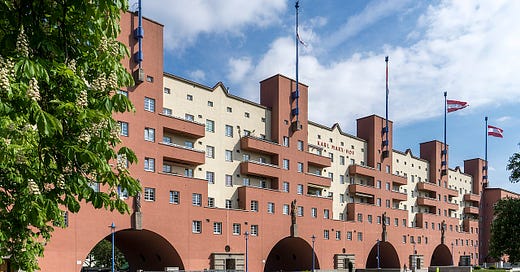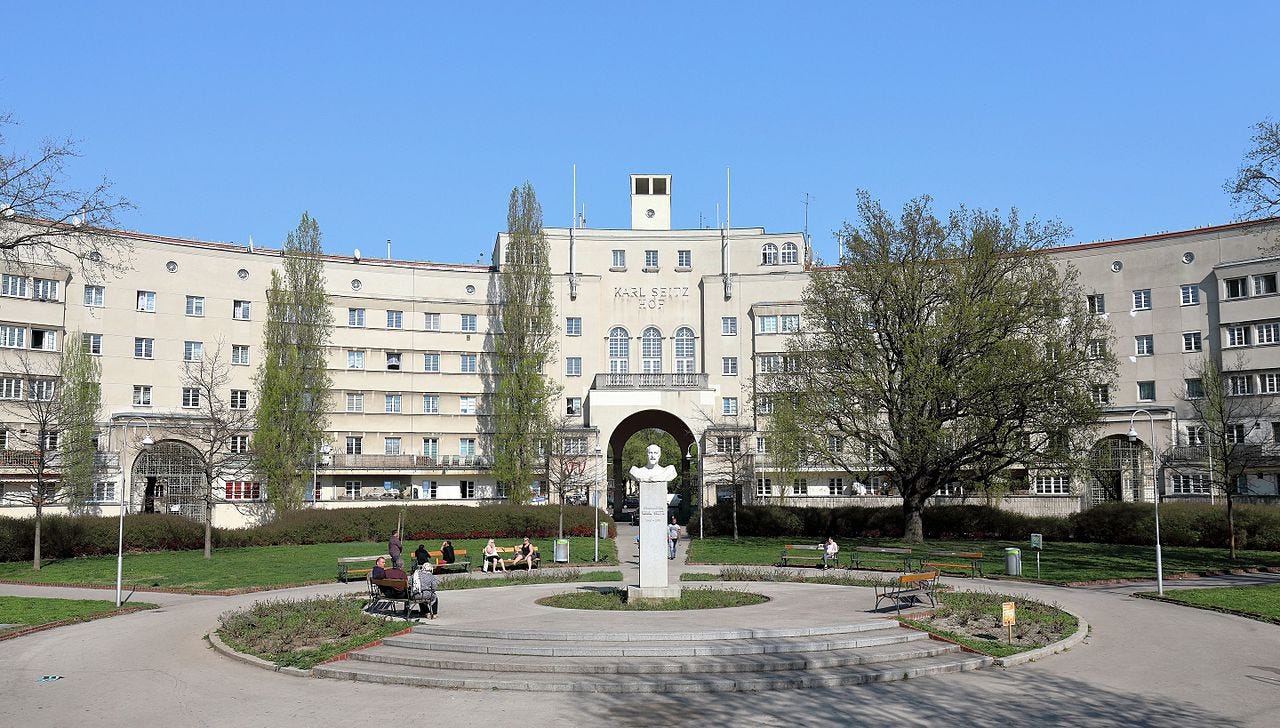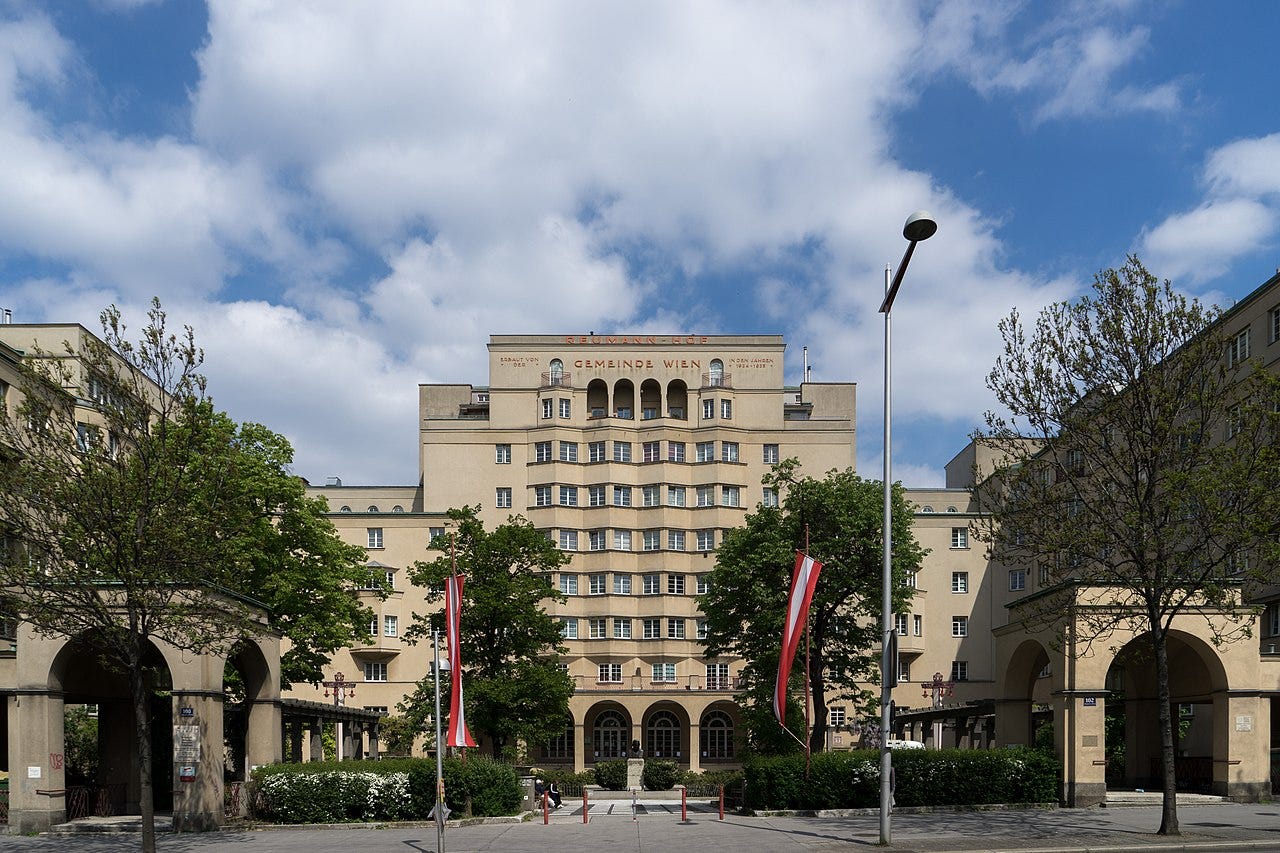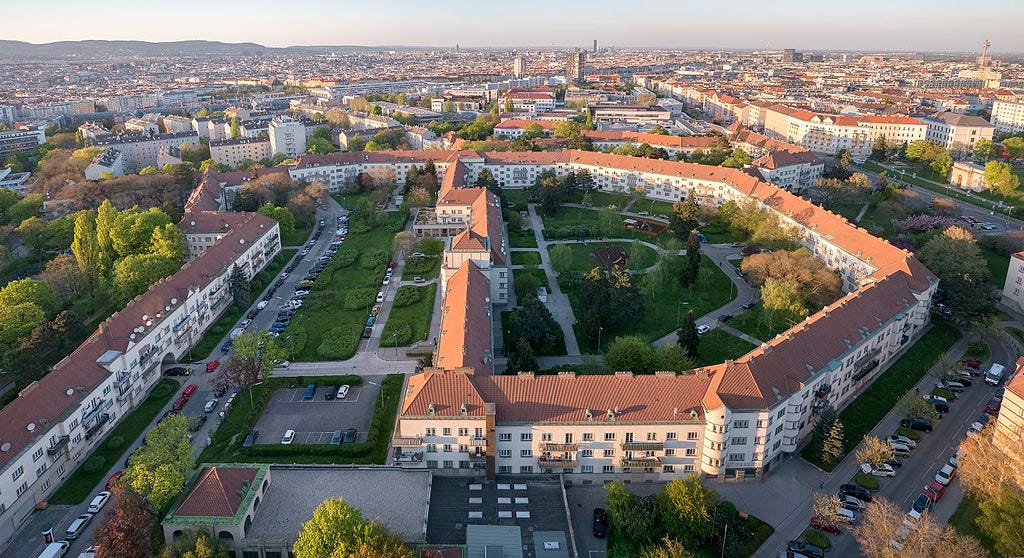Servus!
2023 marks the hundredth anniversary of Vienna’s landmark social housing program. On February 1, 1923, Vienna’s city council passed the introduction of a housing tax designed to fund the construction of subsidized housing in the city. Later that year, on September 21, the council approved the first social housing construction plan, which called for building 25,000 apartments within five years.
Vienna in 1923 was a city of almost two million people. It was still one of the largest cities in the world, the former capital of a landlocked European empire and a melting pot of cultures and languages: German, Czech, Hungarian, Polish, and Yiddish among others. It was also, following the First World War, a poorer city, gripped by shortages, disease, inflation, and political instability. A housing crisis meant that the majority of Viennese residents living in inadequate, unhygienic conditions: apartments consisting of one room and a kitchen, with nowhere to wash and a communal WC on the landing corridor.
In May 1919, elections to Vienna’s city council resulted in a majority for the Social Democratic Workers’ Party (today: the Social Democratic Party, SPÖ) and a social democratic mayor, Jakob Reumann (succeeded in 1923 by Karl Seitz). Those elections marked the beginning of the interwar period known as Red Vienna when, between 1919 and 1934, in contradistinction to the rest of Austria, which tended towards Catholic conservatism, Vienna pursued a radical and ambitious social democratic agenda aimed at transforming the city and the condition of its population. Its cornerstone was its housing program.
Between 1923 and 1932, the city built 65,000 new social housing units. By 1931, around a tenth of Vienna’s population lived in a council flat. These apartments remained small by international standards—a minimum of 38 square meters or 410 square feet. But the apartments comprised of two rooms—one larger, one smaller—plus a kitchen, a WC, and a vestibule. They had electricity and gas, and were filled with fresh air and natural light. Apartments built after 1929 included a bathtub in the kitchen; before then, people either had mobile tubs they stored in their cellars and brought upstairs as required or availed themselves of communal washing facilities, Brausebäder, some of which still exist in Vienna.
The need to build thousands of new apartments in a short period of time led to a certain amount of uniformity in design and construction. Social housing from the interwar period is instantly recognizable for that very reason, built using brick instead of concrete and finished with standardized doors and windows. The apartments were also erected on a monumental scale: prestige projects in the city’s outer districts made up of hundreds of apartments and communal facilities like launderettes, libraries, and kindergartens built around green spaces. The Karl-Marx-Hof, George-Washington-Hof, Rabenhof, Karl-Seitz-Hof, and Wohnhausanlage Sandleiten remain fine examples of social housing from the period.
In the former launderette at the Karl-Marx-Hof (whose time passed once washing machines became an affordable white good), the exhibition “Schöner Wohnen im Roten Wien” runs until December 17 and shows in greater detail how social housing fit into the SPÖ’s greater, utopian social democratic project, which ended with the rise of Austrofascism and death of Austrian democracy in 1934. If you’re in Vienna this summer, you might also consider walking the course of Stadtwanderweg 11, whose course runs along the Gürtel—the Ringstrasse of the proletariat—past social housing projects like the Reumannhof, ending up at Reumannplatz in the tenth district, home of the Amalienbad, a magnificent public swimming pool from the era of Red Vienna.
Bis bald!
Thank you for subscribing to the Vienna Briefing. If you know someone who might be interested in receiving this newsletter, consider sharing it with them today.
The Vienna Briefing is a reader-supported publication. If you would like to support my work, think about sending me a tip via PayPal. Thank you to all contributors.
New Healthcare Spending
Austria’s government is to spend €200 million on new measures designed to plug gaps in the country’s healthcare system, which include a lack of specialists that take public insurance. At their summer retreat, the government also announced that its annual financial support for Austria’s Jewish community would increase from €4 million to €7 million.
Inflation Continues To Fall
The rate of inflation fell to 7.0 percent in July, down from 8.0 percent in June, according to initial estimates. Lower prices for petrol, diesel, and home heating oil were among the biggest contributors to falling inflation.
Taking Saudi Money
Soccer coach Matthias Jaissle has left Red Bull Salzburg to take over at Al Ahli Saudi FC, a Saudi Pro League side owned by the government’s Public Investment Fund. Without Jaissle, Salzburg won their opening game of the Bundesliga season on Saturday, beating Altach 2-0.







